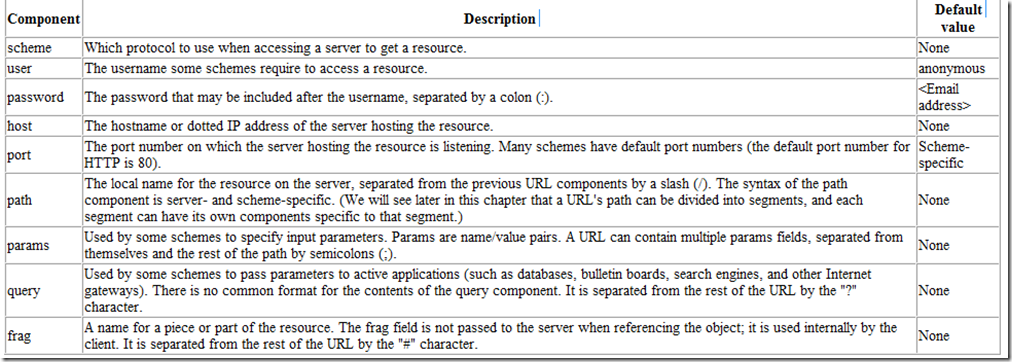2.2 URL Syntax
URLs provide a means of locating any resource on the Internet, but these resources can be accessed by different schemes (e.g., HTTP, FTP, SMTP), and URL syntax varies from scheme to scheme.
Does this mean that each different URL scheme has a radically different syntax? In practice, no. Most URLs adhere to a general URL syntax, and there is significant overlap in the style and syntax between different URL schemes.
Most URL schemes base their URL syntax on this nine-part general format:
<scheme>://<user>:<password>@<host>:<port>/<path>;<params>?<query>#<frag>
Almost no URLs contain all these components. The three most important parts of a URL are the scheme, the host, and the path. Table 2-1 summarizes the various components.
Table 2-1. General URL components

2.2.1 Schemes: What Protocol to Use
The scheme is really the main identifier of how to access a given resource; it tells the application interpreting the URL what protocol it needs to speak. In our simple HTTP URL, the scheme is simply "http".
The scheme component must start with an alphabetic character, and it is separated from the rest of the URL by the first ":" character. Scheme names are case-insensitive, so the URLs "http://www.joes-hardware.com" and "HTTP://www.joes-hardware.com" are equivalent.
2.2.2 Hosts and Ports
To find a resource on the Internet, an application needs to know what machine is hosting the resource and where on that machine it can find the server that has access to the desired resource. The host and port components of the URL provide these two pieces of information.
The host component identifies the host machine on the Internet that has access to the resource. The name can be provided as a hostname, as above ("www.joes-hardware.com") or as an IP address. For example, the following two URLs point to the same resource—the first refers to the server by its hostname and the second by its IP address:
http://www.joes-hardware.com:80/index.html
http://161.58.228.45:80/index.html
The port component identifies the network port on which the server is listening. For HTTP, which uses the underlying TCP protocol, the default port is 80.
2.2.3 Usernames and Passwords
More interesting components are the user and password components. Many servers require a username and password before you can access data through them. FTP servers are a common example of this. Here are a few examples:
ftp://ftp.prep.ai.mit.edu/pub/gnu
ftp://anonymous@ftp.prep.ai.mit.edu/pub/gnu
ftp://anonymous:my_passwd@ftp.prep.ai.mit.edu/pub/gnu
http://joe:joespasswd@www.joes-hardware.com/sales_info.txt
2.2.4 Paths
The path component of the URL specifies where on the server machine the resource lives. The path often resembles a hierarchical filesystem path. For example:
http://www.joes-hardware.com:80/seasonal/index-fall.html
2.2.5 Parameters
For many schemes, a simple host and path to the object just aren't enough. Aside from what port the server is listening to and even whether or not you have access to the resource with a username and password, many protocols require more information to work.
2.2.6 Query Strings
Some resources, such as database services, can be asked questions or queries to narrow down the type of resource being requested.
2.2.7 Fragments
Some resource types, such as HTML, can be divided further than just the resource level. For example, for a single, large text document with sections in it, the URL for the resource would point to the entire text document, but ideally you could specify the sections within the resource.
To allow referencing of parts or fragments of a resource, URLs support a frag component to identify pieces within a resource. For example, a URL could point to a particular image or section within an HTML document.
A fragment dangles off the right-hand side of a URL, preceded by a # character. For example:





















 2805
2805











 被折叠的 条评论
为什么被折叠?
被折叠的 条评论
为什么被折叠?








